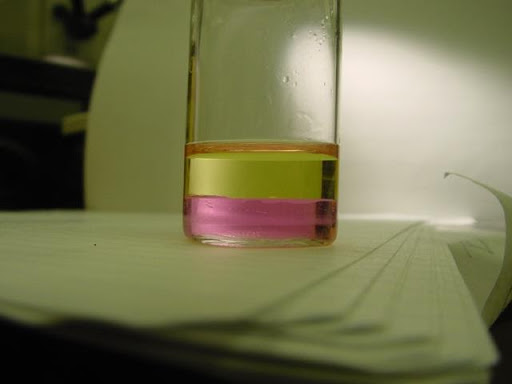Activatable probes
The field of molecular imaging intensified with the development of contrast agents that can sense their environment.These agents make it possible to measure functional activity or dynamic changes of targets of interest. We are developing activable contrast agents that span a range of sizes from small molecule to nanoparticle to macromolecular. We have designed ground-breaking, reversibly-activatable contrast agents. We designmolecules to sense light productionin biological models that overexpress light producing molecules and enzymes. These probes are based on photoswitches such as spiropyrans.
Representative papers:
- Tu C, Nagao R, Louie AY*“Multimodal Magnetic-Resonance/Optical-imaging contrast agent sensitive to NADH” Angew. Chemie (2009) 48:6547-6551.
- Osborne E, Jarrett BR, Tu C, Louie AY*, “Modulation of T2 relaxation time by light-induced, reversible aggregation of magnetic nanoparticles” JACS (2010) 137(17):5934-5935.
- Balmond E^, Tautges B^, Faulkner A, Or V., Hodur B, Shaw JT, Louie AY* Comparative Evaluation of Substituent Effect on the Photochromic Properties of Spiropyrans and Spirooxazines”. (2016) Journal of Organic Chemistry,81(19):8744-8758 DOI
- Garcia J, Addison B, Liu S, Lu L, Faulkner AL, Hodur BM, Shaw JT, Frank NL, Louie AY*Antioxidant Sensing by Spiropyrans: Substituent Effects and NMR Spectroscopic Studies J. Phys. Chem. B (2019) 123, 6799−6809

Macrophage targeting
Macrophages play key roles in inflammation and disease progression and it has become increasingly recognized that phenotype is plastic and macrophages exist in a wide spectrum of functional states. We are developing probes and methods to identify specific macrophage subtypes through imaging by MRI. These probes encompassa range of technologies from macromolecules and nanoparticles to lipid particles.We are studying applications in 1H-MRI and 19F-MRI.
Representative papers:
- Gustafsson, Youens S, Louie AY*: “Development of Contrast Agents Targeted to Macrophage Scavenger Receptors for MRI of Vascular Inflammation”, Bioconjugate Chemistry (2006) 17:538-547.
- Jarrett BJ, Frendo M, Vogan J, Louie AY*: “Size controlled synthesis of dextran sulfate coated iron oxide nanoparticles for magnetic resonance imaging”, Nanotechnology (2007) 18(3):035603.
- Tu C, Ng T, Jacobs RJ, Louie AY*“Multimodality imaging probes targeted to activated macrophages” (2014) JBIC, doi 10.1007/s00775-013-1054-9.

Cardiovascular Applications
Atherosclerosis is a leading cause of death worldwide. Currently, angiography is the primary clinical method for diagnosing atherosclerosis, but angiography can only assess lumenal occlusions. Increasing evidence indicates that it is atherosclerotic plaque rupture rather than severity of occlusion that leads to acute infarction or sudden cardiac death. However, sensitive detection and differentiation of vulnerableversus stable atherosclerotic plaques in vessels remains limited. There is evidence thatcomposition and presence of specific markers can indicate if a plaque is at risk for rupture. Our research focuses on development of multifunctional nanoparticles targeted to atherosclerotic markers for multimodality imaging of atherosclerotic plaques. We have developed multimodal probes for PET/MR/optical imaging based and are currently working on novel nanomaterials for clot prevention.
Representative papers:
- Jarrett BJ, Correa C, Ma KW, Louie AY*, “Multimodal Imaging of Vascular inflammation with targeted MRI/PET contrast agents” PLoS One (2010) 5(10:e13254-.
- Jarrett BJ, Gustafsson B, Kukis D, Louie AY*“Synthesis of 64Cu-labeled magnetic nanoparticles for molecular imaging” Bioconjugate Chemistry (2008) 19(7):1496-1504.
- Tu C, Ng T, Sohi H, Palko H, House A, Jacobs R, Louie AY“Receptor-targeted Iron Oxide Nanoparticles for Molecular MR Imaging of Inflamed Atherosclerotic Plaques” (2011) Biomaterials 32, 7209.
- Tang T, Tu C, Chow S, Leung K, Du S, Louie AY “Quantitative Assessment of Binding Affinities for Nanoparticles Targeted to Vulnerable Plaque” (2015) Bioconjugate Chemistry DOI: 10.1021/acs.bioconjchem.

Innovative Education Projects
Dr. Louie believes teaching is one of the most important and rewarding aspects of the academic profession and has regularly engaged in activities to improve the instructional methods and expand opportunities for students. She has been the PI of an NIH R25 to improve biomedical engineering design instruction, and effort which included developing virtual clinical needs assessment experiences at the veterinary and human hospitals at UC Davis. She was the PI and lead for the Beckman Scholars Program at UC Davis to provide enriching research experiences for the most talented undergraduates. She was the recipient of a PHCA award to create an online game for her Introduction to Research class. This novel idea was based on the observation that while people can be occupied by gaming for hours, it is difficult to watch a lecture online for more than 10 minutes. This award supported the creation of a game that revisits and solidifies the topics of each week’s lectures. Dr. Louie currently is the PI for an award from the California Learning Lab to develop eGames to teach engineering design. More information about this project can be found here: https://opr.ca.gov/learninglab/grants/awards/e-games-for-active-training.html
Representative paper:
- Mittal V†, Thompson M†, Altman S†, Taylor P†, Summers A†, Goodwin K†, Louie AY*“Clinical Needs Finding: Developing the Virtual Experience, A Case Study”. (2013) Annals of Biomedical Engineering DOI:10.1007/s10439-013-0783-9
